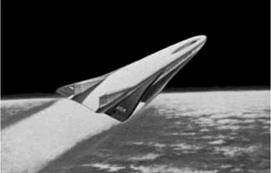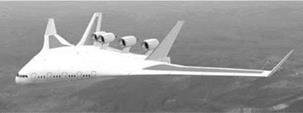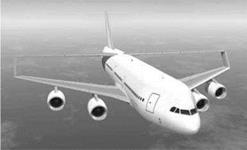Civil Aircraft Design: Future Trends
The speed-altitude extension will progress initially through supersonic transport (SST) and then hypersonic transport (HST) vehicles. The SST technology is well proven by three decades of the Anglo-French-designed Concorde, which operated above Mach 2 at a 50,000-ft altitude carrying 128 passengers.

The next-generation SST will have about the same speed-altitude capability (possibly less in speed capability, around Mach 1.8), but the size will vary from as few as 10 business passengers to approximately 300 passengers to cover at least transatlantic and transcontinental operations. Transcontinental operations (Figure 1.12) would demand sonic-shock-strength reduction through aerodynamic gains rather than speed reduction; anything less than Mach 1.6 has less to offer in terms of time savings. The real challenge would be to have HST (Figure 1.13) operating at approximately Mach 6 that would require operational altitudes above 100,000 ft. Speed above Mach 6 offers diminishing returns in time saved because the longest distance necessary is only 12,000 nm (i. e., «3 hours of flight time). Military applications for HST vehicles are likely to precede civil applications.
|
Considerable development in power plant technology is required to make either SST or HST commercially viable. Small-scale HST has been flown recently.
A new type of speed-altitude capability will come from suborbital space flight using rocket-powered aircraft, as demonstrated by Rutan’s Space Ship One that hitchhiked with the White Knight to altitude (Figure 1.14), from where it made the ascent. Interest in this aircraft has continued to grow – the prize of $10 million offered could be compared with that of a transatlantic prize followed by commercial success. A larger Space Ship Two is currently being developed.
Any extension of payload capability will remain subsonic for the foreseeable future and will lie in the wake of gains made by higher-speed operational success. High-capacity operations will remain around the size of the Airbus 380. Further size increases will use the benefits of a blended wing body (BWB) because the wing – root thickness would be sufficient to permit merging (Figure 1.15) with the fuselage, thereby benefiting from the fuselage’s contribution to lift (see Section 3.20 for BWB configurational advantages). Another alternative would be that of the joined-wing concept (Figure 1.16). Studies of twin-fuselage, large transport aircraft also have shown potential.
Both operators and manufacturers will be alarmed if the price of fuel continues to rise to a point where the air transportation business finds it difficult to sustain operations. The industry would demand that power plants use alternative fuels such as biofuel, liquid hydrogen (LOH), and possibly nuclear power for large transport aircraft covering long ranges. Aircraft fueled by LOH have been used in experimental flying for some time, and fossil fuel mixed with biofuel is currently being flight-tested.
A new type of vehicle known as a ground-effect vehicle is a strong candidate for carrying a large payload (e. g., twice that of the Boeing 747) and flying close to the
 Figure 1.15. Blended wing body aircraft (Airbus)
Figure 1.15. Blended wing body aircraft (Airbus)
Figure 1.16. Joined-wing aircraft (Airbus)
 surface, almost exclusively over water (Figure 1.17). (A ground-effect vehicle is not really new: The Russians built a similar vehicle called the “Ekranoplan,” but it did not appear in the free market economy.)
surface, almost exclusively over water (Figure 1.17). (A ground-effect vehicle is not really new: The Russians built a similar vehicle called the “Ekranoplan,” but it did not appear in the free market economy.)
Smaller Bizjets and regional jets will morph, and unfamiliar shapes may appear on the horizon, but small aircraft in personal ownership used for utility and pleasure flying are likely to revolutionize the concept of flying through their popularity, similar to how the automobile sector grew. The revolution will occur in short-field capabilities, as well as vertical takeoffs, and safety issues in both design and operation. Smaller aircraft used for business purposes will see more private ownership to stay independent of the more cumbersome airline operations. There is a good potential for airparks to grow. The NASA, the U. S. Department of Transportation (USDOT), FAA, industry stakeholders, and academia have joined forces to pursue a National General Aviation Roadmap leading to a Small Aircraft Transportation System (SATS). This strategic undertaking has a 25-year goal to bring the next generation of technologies to and improve travel between remote communities and transportation centers in urban areas by utilizing the nation’s 5,400 public-use general-aviation airports (United States). The density of these airfields in Europe is much higher. The major changes would be in system architecture through miniaturization, automation, and safety issues for all types of aircraft.












